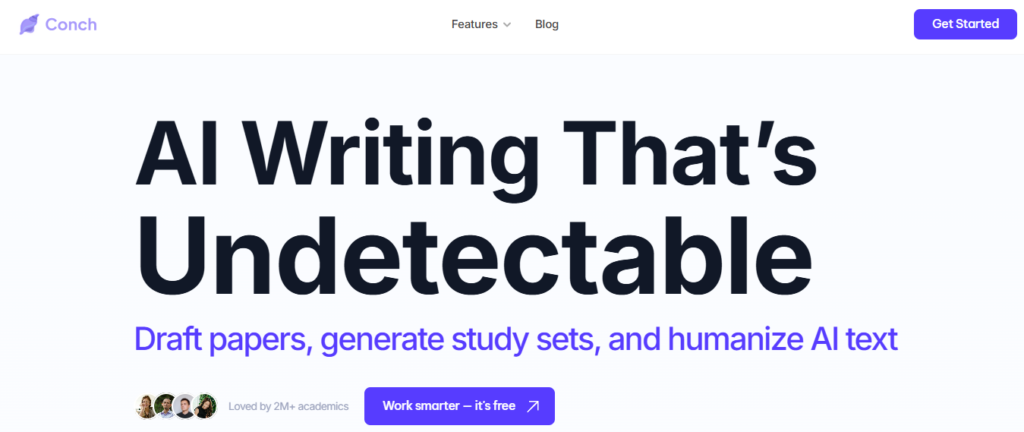Writing a diversity essay can be a stressful experience. You want to impress the admissions committee by writing a compelling personal statement that reflects your individuality and unique experiences with diversity and inclusion. Clear examples can help you get there. In this guide, we’ll explore diversity essay examples, including what they are, their importance, and how to use them to write a stellar diversity essay for college applications. We’ll also touch on how to use AI to write a paper, especially if you’re looking for support with brainstorming, structure, or polishing your final draft—without losing your authentic voice.
If you’re feeling stressed about the upcoming task of writing a diversity essay, you are not alone. Let’s alleviate some of that pressure by examining what a diversity essay is, why they matter, and how to utilize AI to write a paper on diversity. Conch AI’s AI writing tool can help you achieve your goals.
What is a Diversity Essay?

A diversity essay is a personal statement often required in applications, designed to showcase what makes you unique beyond your academic achievements or test scores. While many think it only concerns factors like race, gender, class, or sexuality, the concept of diversity is far more expansive and personal. It is an opportunity to highlight aspects of your identity, experiences, beliefs, or background that make you unique and distinguish you from others.
Diversity means different things to different people. It can include traditional identity markers such as ethnicity or socio-economic status, but it also embraces less obvious attributes. These can be unique skills, unusual life experiences, distinct family roles, or even a combination of multiple identity factors. The key is to express your individuality and what truly matters to you.
When considering what to write about, reflect on questions like:
- Do you have a unique skill, talent, or hobby that sets you apart?
- Are your values or beliefs notably different from those around you?
- Have you experienced something rare or impactful, such as running a marathon or witnessing a once-in-a-lifetime event?
- Do you hold a special life role, such as caregiving for a family member or coming from a tiny community?
Suppose you belong to an underrepresented group, such as an immigrant or a member of an ethnic minority. In that case, you have a direct opportunity to demonstrate how your perspective will enrich the community to which you are applying. However, even if you do not fit these categories, you can still write a meaningful diversity essay. Unique experiences, such as volunteering as an EMT, participating in dance troupes, or supporting marginalized groups, can effectively illustrate your potential contributions.
You might also highlight being the first in your family to pursue college, learning English as a new language, or other distinctions that give you a unique viewpoint. Importantly, diversity encompasses more than visible traits or social categories. It involves whatever element of your identity sets you apart and indicates you also value diverse perspectives. In this way, a well-crafted diversity essay becomes a platform to share those defining parts of yourself and how they will enrich your future academic community.
Ultimately, what distinguishes a diversity essay is not just what you write about, but how authentically you communicate your story and perspective. By reflecting honestly, leveraging innovative tools like Conch AI to hone your draft, and focusing on aspects of your life that truly matter to you, you ensure your application stands out in a meaningful way.
Join Over 2 Million Students and Ace your Classes with our AI Writing Tool
Join millions of students to write papers and ace exams with Conch AI’s AI writing tool. We built this tool because we were tired of spending endless hours on citations, study guides, and rewrites. Unlike general AI tools, Conch understands what students need – instant citations that professors accept, stealth writing that bypasses detection, and study tools that help you learn the material.
Our Chrome extension superpowers are right at your fingertips, enhancing your research workflow. Meanwhile, our lecture recording feature takes notes for you, allowing you to focus on understanding the concepts. Try our free plan today and see why students tell us they’re saving 10+ hours a week with Conch AI. When you’re ready for unlimited access, our Limitless Plan gives you everything you need to transform your academic experience. Join over 2 million students and ace your classes with our AI writing tool!
Related Reading
- How to Calculate H Index
- How to Write an Informative Essay
- Technology Essay
- How to Write a Header for an Essay
- How to Write a Biography Essay
- How to Write a Reflection Paper
- How to Write an Encyclopedia Entry
- Speech Analysis Example
- What is a Good H Index
Why Schools Value Diversity

Schools place a high value on diversity because it enriches the learning environment for everyone. When students from varied ethnicities, religions, sexual orientations, and backgrounds come together, they bring unique viewpoints that enhance classroom discussions. This mix of perspectives broadens understanding and promotes deeper thinking.
Diversity extends beyond academics, shaping interactions in dorms, dining areas, and study groups to create a dynamic community where students learn from one another’s experiences. Such an environment fosters respect and open-mindedness. This social growth is essential for personal development. Moreover, schools recognize that the world is becoming increasingly global and multicultural. Preparing students to thrive in this reality is a key goal. Exposure to diverse cultures and ideas equips graduates with the skills needed to work effectively in diverse teams and global settings.
In fields like medicine, diversity is crucial. Healthcare providers who understand diverse cultural backgrounds can offer more effective care to underrepresented populations. Similarly, businesses benefit by having employees from varied backgrounds who can connect with a wide range of customers. Schools foster diversity to ensure their graduates succeed in these modern workplaces. Ultimately, valuing diversity helps schools build inclusive communities while preparing students for the future job market. By encouraging varied voices and experiences, educational institutions contribute to a more equitable and innovative society.
Diversity Essay Examples

1. Navigating the World with a Physical Disability
The linoleum floor in my high school’s hallway was slippery after the morning rain. As students rushed by, I tightened my grip on my crutch, wary of the extra slide beneath my foot. Born with cerebral palsy, I move differently from most. The simple act of getting to class is a calculated journey, eyeing the floor, anticipating sudden bursts of commotion, and willing my leg to cooperate for just five more minutes.
My physical difference makes me noticeable, sometimes in ways I wish I weren’t. “Are you okay?” or “What happened?” echo as frequently as “Good morning.” My disability has been a magnet for curiosity, pity, and at times, awkward distance. Group projects often start with hesitation: classmates worrying about overburdening me, or assuming I’ve already decided my limitations.
But I have discovered so much about myself walking these halls. My crutch is more than a tool. It is a symbol of the determination I bring to each challenge. When I signed up for the debate team as a sophomore, voices questioned my stamina to stand during long tournaments. By competition’s end, my teammates and I celebrated a third-place finish, and I’d proven something to myself and to them: my ideas and voice were just as strong as anyone’s.
Living with a visible disability has given me a unique perspective on empathy, resilience, and the underestimated power of listening. I know the discomfort of being an outsider, but I also see the warmth that comes when someone steps past that barrier, when peers treat me as a teammate first, a student second, and as someone with a disability last.
I plan to continue challenging assumptions and bridging gaps at my future college. I want to contribute not just my perspective as a student with a disability, but also my commitment to making communities kinder, more aware, and better equipped to understand where accommodation transforms from charity to genuine belonging.
What the Essay Did Well
- Scene Setting: The essay begins with a vivid sensory moment, immediately placing the reader in the author’s shoes and illustrating the daily realities of navigating public spaces with a disability.
- Growth and Self-Reflection: The writer moves from describing others’ reactions to examining how these experiences have honed their resilience and commitment to inclusion.
- Broader Impact: The essay demonstrates not only personal strength but also a desire to foster a more empathetic community, a key aspect for diversity essays.
What Could Be Improved
- More Actionable Outcomes: The essay could provide specific examples of how the writer has advocated for accessibility or inclusion within the school, adding more tangible proof of their commitment.
- Balancing Tone: While the essay is honest about challenges, additional moments of humor or joy could enhance depth and provide variety to the emotional tone.
2. A Multiracial Identity in a Divided World
At family gatherings, the aroma of adobo mingles with the laughter that rises over dominoes and old R&B songs. My Filipino mother and African American father taught me to love both steamed rice and soul food, and to cherish Simbang Gabi before Christmas and Juneteenth each summer. Yet, outside our home, this mixture often felt less like a celebration and more like an interrogation.
“Wait, what are you, exactly?” classmates would ask, eyes searching for clues in my skin tone, hair, or last name. “Why don’t you pick a side?” was whispered by both communities when I joined spaces intended to empower one or the other. These moments of exclusion, although minor and often unintentional, forced me to navigate questions of identity earlier and more intensely than many of my peers.
In high school, I channeled this discomfort into action, joining the Diversity Council and eventually founding a “Mixed Heritage” affinity group. Our meetings became a haven —a place where students with diverse backgrounds could share challenges, jokes, and family recipes; a space where “both/and” was the rule, not the exception. I organized dialogues between groups and worked with faculty to revise our curriculum on race, ensuring that mixed and multiracial voices were visible and valued.
Having lived and often felt invisible at the intersection of different cultures, I have developed uncommon flexibility, empathy, and a genuine curiosity about others’ stories. Rather than shrinking from difficult conversations about race, language, or privilege, I feel equipped to help others bridge gaps and see nuance, even in heated debates.
At college, I look forward to fostering spaces where all students, especially those whose stories defy easy labels, feel empowered to take up space and shape the campus community.
What the Essay Did Well
- Specificity and Scene Setting: The opening description draws the reader in with rich, sensory details of family life, grounding the essay in lived experience.
- Action and Impact: The writer offers concrete examples, including founding an affinity group, advocating for curriculum change, demonstrating leadership, and making a long-term commitment to inclusion.
- Concrete Self-Reflection: Instead of merely describing the feeling of being “in between,” the essay demonstrates how this position led to the development of unique skills and a drive to connect communities.
What Could Be Improved
- Greater Depth in Challenges: While the essay names the struggle of belonging, more vivid or personal anecdotes about particularly formative moments of exclusion could heighten emotional impact.
- Expanding Forward-Looking Statement: The conclusion could be more specific about how the writer intends to contribute to diversity efforts in college, perhaps by naming organizations or initiatives of interest.
3: Growing Up in a Rural LGBTQ+ Community
The only rainbow flag in my rural town fluttered outside our tiny library, half-hidden behind a creaking maple. I spent most of middle school passing by that flag with quick steps, my eyes cast down. Coming out as non-binary in a community where “diversity” was more often applied to corn crops than people required a quiet sort of courage, one built from whispered confidences and late-night journaling under the covers.
When I finally decided, during sophomore year, to wear a pronoun pin to school, the reaction was mixed. My world was divided sharply: classmates who nodded in reassurance, teachers who quietly used my correct pronouns, and others who offered only silence or sidelong looks. There were hard days, days I avoided the cafeteria, or found “they/them” crossed out and replaced with “she/her” in the yearbook draft.
But I found allies in unexpected places. The elderly librarian invited me to help organize an LGBTQ book section; together, we celebrated Pride Month with a window display of stories written by and for people like me. I started a weekly support circle for questioning students, tucked into the back corner of the library. I watched as hesitant first-timers became regulars, each finding the words to describe themselves in their own time.
Living out loud in a place not always built for difference taught me grit, empathy, and how to build bridges instead of walls. At college, I am eager to expand on this work by partnering with campus LGBTQ groups, advocating for inclusive policies, or simply listening to and amplifying the voices of marginalized individuals.
What the Essay Did Well
- Vivid Scene-Setting: The essay opens with a memorable image of the only pride flag in town, immediately situating the reader in the student’s environment.
- Personal Growth and Action: The student’s journey from fear to advocacy, including founding a support circle and collaborating with a librarian, provides clear examples of leadership and impact.
- Emotional Honesty: Sharing both setbacks and victories lends authenticity, making the story relatable and compelling.
What Could Be Improved
- More Specific College Goals: While the conclusion expresses a desire to contribute, naming specific initiatives or programs at the prospective college would demonstrate a more apparent intent.
- Succinct Language: Some sentences could be condensed for greater impact, sharpening the writing and amplifying the key moments.
Let’s Talk About Conch AI Writing Tool
Join millions of students to write papers and ace exams with Conch AI’s AI writing tool. We built this tool because we were tired of spending endless hours on citations, study guides, and rewrites. Unlike general AI tools, Conch understands what students need – instant citations that professors accept, stealth writing that bypasses detection, and study tools that help you learn the material.
Our Chrome extension brings these superpowers directly to your research workflow, while our lecture recording feature takes notes for you, allowing you to focus on understanding the concepts. Try our free plan today and see why students tell us they’re saving 10+ hours a week with Conch AI. When you’re ready for unlimited access, our Limitless Plan gives you everything you need to transform your academic experience. Join over 2 million students and ace your classes with our AI writing tool!
How to Write About Your Diversity

Writing about your diversity in an application essay means highlighting what makes you unique and how your experiences shape your worldview, character, and contributions to a community. To do this effectively, focus on how your background has fostered empathy, resilience, and a distinctive perspective.
Before you start writing, carefully read the diversity prompt. Schools may ask how you define diversity, how your background adds to the school’s community, or how you plan to contribute to diversity in your profession or neighborhood. Tailor your response to fit what the question asks explicitly, showcasing the unique qualities you bring that enrich the overall community.
To broaden your understanding of diversity and structure your writing, consider these three components:
1. Identity
Reflect on who you are. What parts of your background have shaped you? This could include your ethnicity, gender, sexual orientation, religion, physical ability, family education level, multicultural experiences, or nontraditional educational or work paths. Articulating your identity helps admissions officers see the distinctive lens through which you view the world.
2. Deeds
Think about what you have done that reflects your diversity. Contributions through leadership roles, community service, achievements, work experiences, or overcoming significant challenges all showcase how your background influences your actions. Highlighting accomplishments or obstacles you’ve turned into growth moments adds depth to your story.
3. Ideas
Consider your mindset and approach to life. What motivates you? How do you solve problems or bring people together? Whether you ease tense situations with humor or naturally serve as a connector in groups, sharing how your ideas stem from your unique experiences shows the value you add beyond your identity and deeds.
You don’t need an extraordinary or rare story to write a compelling diversity essay. Every individual’s background contains valuable elements. Look deeply into your identity, your achievements, and your way of thinking. Find aspects that clearly distinguish you and consider how these can contribute to a diverse, vibrant community at your target school.
Final Tips
- Be genuine: Authenticity resonates more than trying to fit a perceived mold.
- Stay focused: Address the prompt directly without veering off-topic.
- Connect to the community: Explain how your diversity will benefit others, not just yourself.
- Avoid clichés: Instead, provide specific examples and personal insights.
Remember, your diversity essay is your chance to demonstrate to the admissions committee that your unique blend of identity, experiences, and perspectives will positively enrich their educational environment. There is genuinely only one you; make that clear in your writing.
Related Reading
- Essay on Respect
- Essay About Bullying
- Why I Deserve This Scholarship Essay
- Is Census Data Primary or Secondary
- Is a Documentary a Primary Source
- Are Textbooks Primary Sources
- Essay About Death
- How to Write a 4 Paragraph Essay
- Finance Research Paper Writing
How to Write a Diversity Essay With Conch AI

Writing a diversity essay with Conch AI becomes an efficient and high-quality process by leveraging its advanced AI-powered writing and editing tools. Below is a detailed guide on how to write a diversity essay using Conch AI, covering key stages from brainstorming to finalizing your draft.
1. Understand Your Diversity Essay Prompt
Before writing, carefully analyze the essay prompt on diversity. Understand what aspects of diversity the essay asks you to address, whether it’s cultural background, identity, experiences, or perspectives. Conch AI can help you brainstorm ideas and break down the prompt into manageable elements, clarifying how to frame your response.
2. Create a Structured Outline with Conch AI
A clear outline is essential for a logical flow in your essay. Use Conch AI to generate an outline based on your initial input or notes. You might structure your essay with:
- Introduction: Present your unique background or diverse perspective to capture the reader’s attention.
- Body Paragraphs: Include specific examples of your experiences or challenges that shaped your identity and viewpoint.
- Conclusion: Summarize how your diverse perspective will positively contribute to the community or context you are addressing.
Conch AI’s ability to expand, summarize, or simplify sections lets you refine your outline progressively.
3. Generate and Refine Content Efficiently
Conch AI accelerates drafting by auto-completing sentences or paragraphs that align with your outlined points. Its AI Autocomplete feature suggests the following sentence based on your writing, helping you overcome writer’s block.
You can also use commands to:
- Paraphrase: Reword content to maintain originality.
- Make Longer or Shorter: Adjust length to meet word count requirements.
- Simplify Complex Ideas: Ensure clarity while communicating intricate diversity themes.
4. Humanize Your Essay and Avoid AI Detection
One paramount feature of Conch AI is its built-in AI Humanizer, which checks your text against AI plagiarism and detection tools, such as GPTZero and Turnitin. This tool revises the text to sound authentic and human-like, ensuring your essay reflects your voice and creativity. This feature ensures that your essay will be accepted by academic institutions that require originality.
5. Cite Sources Automatically
If your diversity essay involves research or referencing external sources, Conch AI provides auto-citations to appropriately credit sources. This feature helps maintain academic integrity without manual citation efforts.
6. Edit, Review, and Finalize
Use Conch AI’s editing tools to check grammar, punctuation, and overall flow. The edit or review command helps identify inconsistencies and improve writing quality. You can also ask AI for opposing arguments or deeper insights to strengthen your essay’s content.
Additional Tips for Writing a Diversity Essay with Conch AI
- Share Your Personal Story: Utilize Conch AI to craft narratives that highlight your unique experiences and challenges.
- Focus on Core Diversity Issues: Address significant aspects such as race, gender, or socio-economic background without diluting your message.
- Avoid False Parallels: Conch AI can help rephrase comparisons to ensure accurate and meaningful representation of your experiences.
Related Reading
- Ai Annotated Bibliography
- Leadership Essay Examples
- Social Media Argumentative Essay Topics
- Topic Sentence vs Thesis Statement
- Evaluation Essay Examples
- National Honor Society Essay Examples
- Proposal Essay Examples
- Literary Analysis Essay Examples
- Informative Essay Topics
- Dyslexia Writing Examples
Join Over 2 Million Students and Ace your Classes with our AI Writing Tool
Conch AI is an academic writing tool that helps students write better papers and ace their exams. We built this AI tool because we were tired of spending endless hours on citations, study guides, and rewrites. With Conch AI, you can write papers faster, with less effort. The tool helps you take control of the writing process and generate high-quality content that meets your academic needs.
For example, Conch AI can help you create detailed study guides for your classes, rewrite paragraphs to improve clarity and structure, and even generate instant citations in various formats to assist with your research. What sets Conch AI apart from other writing tools is that it understands the specific needs of students. Unlike general AI tools, Conch AI provides features that help you perform better in school. Its Chrome extension brings these superpowers right to your research workflow, while its lecture recording feature takes notes for you, allowing you to focus on understanding concepts.

Leave a Reply